Toyota HiAce
The Toyota HiAce (Japanese: トヨタ・ハイエース, Toyota Haiēsu) (pronounced as "High Ace") is a light commercial van produced by the Japanese automobile manufacturer Toyota. First launched in October 1967, the HiAce has since been available in a wide range of body configurations, including a minivan/MPV, minibus, panel van, crew van, pickup truck, taxi and an ambulance. In Japan, the HiAce is exclusive to Toyopet Store locations.
| Toyota HiAce | |
|---|---|
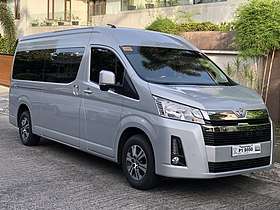 | |
| Overview | |
| Manufacturer | Toyota |
| Production | October 1967 – present[1] |
| Body and chassis | |
| Class | |
| Body style |
|
| Platform | H-series |
First generation (H10)
| First generation (H10) | |
|---|---|
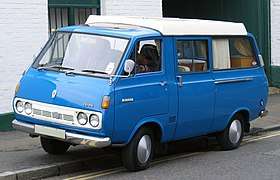 Toyota HiAce camper van | |
| Overview | |
| Production | October 1967 – January 1977[1] |
| Assembly |
|
| Body and chassis | |
| Body style |
|
| Layout | Front-engine, rear-wheel-drive |
| Related | Toyota ToyoAce |
| Powertrain | |
| Engine | |
| Transmission | 4-speed manual |
| Dimensions | |
| Wheelbase | 2,350 mm (93 in) |
| Length | 4,305 mm (169.5 in) |
| Width | 1,690 mm (67 in) |
| Height | 1,890 mm (74 in) |
| Curb weight | 1,130 kg (2,490 lb) |
_(1974_N-Registration).jpg)
In the late 1960s, Toyota Auto Body, a Toyota subcontracting company, led the development of the HiAce as a small van with a one-box design, similar to European ones at the time, but, according to former Toyota senior employee Akira Kawahara, something unseen in the Japanese industry.[7]
Introduced in 1967, the HiAce was offered as a cab over pick-up, delivery van, and a stretched commuter vehicle. It was also called the HiAce Commercial in camper van configuration. It was brought to market two years after the introduction of the Nissan Homy, acquired by Nissan when they assumed operations of the Prince Motor Company. A few engines of different sizes were available upon introduction, ranging from the 70 PS (51 kW) 1.35 to a 83 PS (61 kW) 1.6-litre version.[5][6] In 1975, the 1.8-litre 16R engine was added. The HiAce was available with a heater, considered a luxury item at the time.
The HiAce was primarily designed as a commuter vehicle, able to transport up to 8 people. With this goal in consideration, the HiAce exterior dimensions and engine displacement were in compliance with Japanese government regulations so as to encourage sales, and accommodate the most passengers by utilizing a cabover body style, with the engine installed underneath and between the front passengers. It was a smaller alternative to the larger Toyota Coaster minibus, and was introduced to Japan after the 1950 Volkswagen Transporter, and the 1961 Chevrolet Greenbrier cabover vans. It was introduced in the same year as the much smaller Toyota MiniAce, which was based on the Toyota Publica, a predecessor to the Toyota Corolla.
This type of HiAce is a rare model these days mostly because of weather wear and rust. HiAce vans originally sold on the European market have largely been exported to Africa and to Southeast Asia where they are used as public transport vehicles.
Second generation (H11/H20/H30/H40)
| Second generation (H11/H20/H30/H40) | |
|---|---|
.jpg) | |
| Overview | |
| Also called | Toyota Commuter |
| Production |
|
| Assembly |
|
| Body and chassis | |
| Body style | |
| Layout | Front-engine, rear-wheel-drive / four-wheel drive |
| Related | Toyota ToyoAce |
| Powertrain | |
| Engine | |
| Dimensions | |
| Wheelbase |
|
| Length | 4,340–4,990 mm (170.9–196.5 in) |
| Width | 1,690 mm (66.5 in) |
| Height | 1,890–2,115 mm (74.4–83.3 in) |
The new HiAce of 1977 featured a longer, and more streamlined cab with single headlights. As the second generations dimensions grew, it was joined by a smaller, junior-level cabover van called the Toyota LiteAce to continue to offer dimensions closer to the first generation. In addition to the petrol engines, a 2.2-litre diesel engine was offered in certain markets. New for the "20–40 series" HiAce was a double-cab pick-up, super-long-wheelbase van, and a super long, high-roof Commuter. The Commuter models can seat up to 15 passengers.[10] The short wheelbase truck initially carried the "H11"-series chassis codes. For the vans, 20 series vans have short wheelbases, 30 series have long, and 40 series have super long wheelbases.
After the third generation was introduced in 1982, certain variants of the second generation continued to be manufactured for several years. A majority of the second generation models were exported from Europe and Japan to African and Asian countries after production ended and are used as public transport vehicles.
_D_back.jpg) Rear view
Rear view HiAce Living Saloon
HiAce Living Saloon_(pickup)_(front)%2C_Kuala_Lumpur.jpg) HiAce pickup
HiAce pickup
Third generation (H50/H60/H70/H80/H90)
| Third generation (H50/H60/H70/H80/H90) | |
|---|---|
_Super_Custom_van_(2015-07-14)_01.jpg) | |
| Overview | |
| Also called |
|
| Production |
|
| Assembly |
|
| Body and chassis | |
| Body style |
|
| Layout | Front-engine, rear-wheel-drive / four-wheel drive |
| Related | Toyota ToyoAce |
| Powertrain | |
| Engine | |
| Transmission | |
| Dimensions | |
| Wheelbase | 2,295–2,795 mm (90.4–110.0 in) |
| Length | 4,425–5,025 mm (174.2–197.8 in) |
| Width | 1,690 mm (66.5 in) |
| Height | 1,890–2,220 mm (74.4–87.4 in) |
A new HiAce van was launched in 1982, with the HiAce pickup truck coming in August 1985. The truck's cab design was common to the bigger ToyoAce light truck, though it had different frontal styling. The truck was a completely different model than the van.
The van's model number contains various wheelbase specification information: 50 series vans have short wheelbases, 60 series have long, and 70 series have super long. The pickup trucks are in the 80 and 90-series. The Toyota Mobile Lounge, displayed at the 1987 Tokyo Motor Show, is based on the HiAce high-roof Commuter. While the van and Commuter were redesigned in 1989, the pickup truck was produced until the 1995 model year, and was the last HiAce based pickup truck. Air-conditioning was offered as standard equipment on some variants from this generation onwards.
%2C_rear_right.jpg) Toyota HiAce Minibus
Toyota HiAce Minibus- Toyota HiAce
Commuter / Ambulance / Van super long high roof
(H7#B / H7#V, 1982–1985)  Toyota HiAce Wagon
Toyota HiAce Wagon
(H5#G, 1985–1989)- Toyota HiAce Truck
(H8# / H9#, 1985–1995) - Interior
Fourth generation (H100)
| Fourth generation (H100) | |
|---|---|
Toyota HiAce Grandcabin | |
| Overview | |
| Also called |
|
| Production | August 1989 – August 2004 |
| Assembly |
|
| Body and chassis | |
| Body style |
|
| Layout | Front-engine, rear-wheel-drive / four-wheel drive |
| Related |
|
| Powertrain | |
| Engine | |
| Transmission |
|
| Dimensions | |
| Wheelbase | 2,330–2,890 mm (91.7–113.8 in) |
| Length | 4,430–5,250 mm (174.4–206.7 in) |
| Width |
|
| Height | 1,920–2,285 mm (75.6–90.0 in) |
| Curb weight | 1,560–2,110 kg (3,439.2–4,651.8 lb) |
The fourth generation model appeared in August 1989 and was available in standard wheelbase and long wheelbase variants; a Grand Cabin; standard wheelbase and long wheelbase van; long wheelbase and super long wheelbase high roof van. The latter shares a body design with the Commuter, which is a 15-seat minibus.
A range of engines were available in the fourth-generation vehicles, ranging from 2.0-litre petrol engines to 3.0-litre turbodiesel engines. The 2.4-litre turbodiesel engine (2L-T) was updated to the electronically controlled 2L-TE in October 1990.[14] Most versions are rear-wheel drive, but part time or full-time four-wheel-drive versions were sold depending on specification level and market. Four-wheel drive models were initially only available with the 2.8-litre 3L diesel engine in the Japanese domestic market, but export markets received petrol options as well. The base model is typically the DX. Upmarket versions included CD, GL and Super GL models.
The facelifted fourth-generation HiAce was launched in August 1993. At this time, the new 3-litre 1KZ-TE turbodiesel replaced the 2L-TE and 3L diesels in HiAce Wagons (passenger car registration) in Japan.[14] The HiAce received a facelift again during 1997 and once more in 2002. In Japanese-market commercial HiAces the 2.8-litre 3L engine was replaced by the larger 5L engine in August 1998, in order to meet stricter emissions standards.[14] Export models were available with a range of different engines to suit local importers, uses, and tax structures.
In the Philippines, the HiAce was first sold in August 1990 with a diesel engine, getting revamped in October 1994. It was revamped again in May 1997 for sale as both a business vehicle and as a family vehicle. The HiAce was first then comes in two variants; the business-oriented 15-seater and the family van-oriented 13-seater. In March 1999, the HiAce 3.0 Grandia and 2.0 GL petrol HiAce variants were launched, as well as the HiAce Commuter, a HiAce meant for business, and the HiAce was facelifted again in that year. In September 2000, the top-of-the-line 3.0 inline-4 diesel HiAce Super Grandia was launched. All came with a standard 5-speed manual transmission. These variants were all sold until June 2005, with the next generation being launched in June of that same year. A special edition HiAce Super Grandia J (Japan edition) was also sold together with the RAV4 J and Revo J from August 2002 to June 2003.
A special model intended to be used as an emergency medical vehicle known as the Toyota HiMedic, was launched in May 1992[15] with sales commencing from June of the same year.[16] It used a 4.0-liter V8 engine shared with the Celsior.[16][17]
RegiusAce
The HiAce was rebadged with a luxury orientation, called the Toyota RegiusAce. It was introduced in August 1999 with different versions called the Regius HiAce and Regius Touring HiAce sold at Toyopet and Vista dealerships. The RegiusAce uses a cab-over layout, meaning that front seat passengers sit on top of the front axle and the 1TR-FE engine is located underneath the floor and between the front passengers.
When the Vista sales network was replaced by the NETZ sales network, the Regius Ace was sold exclusively at the Netz Store. The first generation H100 series was manufactured between 1999 and 2004.
Gallery
_(rear)%2C_Serdang.jpg) Van (RZH103R)
Van (RZH103R)- Wagon 2.4DT Super Custom Living Saloon EX (LH100G)
- Wagon 3.0DT Custom (KZH100G)
- HiMedic ambulance (with high roofline and 1UZ-FE V8 engine)
HiAce (H100) based vans
 Jinbei Haise front (1991–2001)
Jinbei Haise front (1991–2001) Jinbei Haise rear (1991–2001)
Jinbei Haise rear (1991–2001)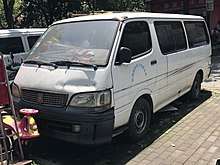 Jinbei Haise first facelift front (1999–2006)
Jinbei Haise first facelift front (1999–2006) Jinbei Haise first facelift rear (1999–2006)
Jinbei Haise first facelift rear (1999–2006) Jinbei Haise second facelift front (2002–2013)
Jinbei Haise second facelift front (2002–2013)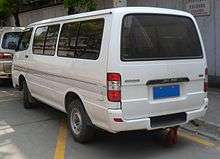 Jinbei Haise second facelift rear (2002–2013)
Jinbei Haise second facelift rear (2002–2013) Jinbei Haise third facelift front (2006–present)
Jinbei Haise third facelift front (2006–present)- Jinbei Haise third facelift rear (2006–present)
 Jinbei Haise fourth facelift front (2008–present)
Jinbei Haise fourth facelift front (2008–present)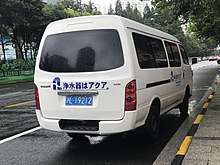 Jinbei Haise fourth facelift rear (2008–present)
Jinbei Haise fourth facelift rear (2008–present)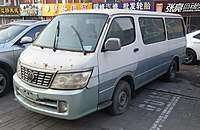 Jincheng GDQ6480A2
Jincheng GDQ6480A2 Foton View C1 (1999–2012)
Foton View C1 (1999–2012)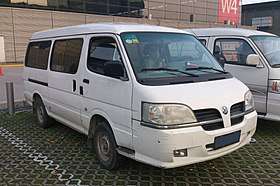 Polarsun Century (2005–2009)
Polarsun Century (2005–2009) Sunlong SLK5030
Sunlong SLK5030
The HiAce (H100) also remains popular in China, where it is still produced by Jinbei Motors, King Long Motors, and Foton Motor Company amongst others. These are exported to several markets, including Chile, and are also assembled in both Egypt (by Bavarian Auto Group) and Sri Lanka (as the Micro MPV J).[18] Common engines found in Chinese HiAce variants are the 2.0 and 2.2-litre (491Q-ME) petrol engines and the 2.8-litre diesel engine. A Chinese variant of the 2.4 L 2RZ-E engine is also available known as the 4RB2. The Isuzu 4JB1 engine and other engine names such as the V19, 4G20C and the 4G22 are available in China as well as 2.5 and 2.7-litre diesel engines. As of 2019, the 2006 variant is still available for purchase with the 4G20, 4G21 and V19 petrol engines available as standard.[19]
In Belarus, the MAZ-182 model is made based on the King Long Haise before it was phased out of production due to lack of interest with plans to eventually localize production.[20][21] The first models (MAZ-181010 and MAZ-182010) were made in December 2010 before it was dropped in 2012, with surviving models found either being used for MAZ personnel or in the streets, some of them as ambulances.[20][22] The models were publicly displayed in 2011.[23]
Granvia, HiAce Regius, Grand HiAce, Touring HiAce (XH10, XH20)
Sold in the Japanese market between 1995 and 2002, the Granvia is a semi-bonneted van, with the front wheels positioned in front of the front seats for better safety. Available with seven- and eight-seater configurations and in rear-wheel drive or four-wheel drive, it is based on the regular HiAce. Because of tighter safety regulations, this model replaced the mid-engined HiAce in Europe and several other markets. The engines for Granvia are either a 2.4 L or 3.0 L diesel, or 2.7- and 3.4 L petrol. The Granvia spawned into the upmarket multi-purpose vehicles the HiAce Regius, the Grand HiAce and the Touring HiAce. The Granvia, Grand HiAce, and Touring HiAce are upmarket passenger vans only.
In Europe, the Granvia-based HiAce sold from 1995 was usually equipped with the 2494 cc 2KD diesel engine in a variety of versions, with or without turbocharging. The HiAce underwent a facelift in 2006, with bigger "jewel-style" headlights, and continued to be built in this form until 2012, replaced by the Toyota ProAce.
In Australia, the Granvia was sold as the HiAce SBV, alongside the fourth generation HiAce, and both were replaced by the new fifth generation model. The HiAce SBV sold in Australia (from 1996 to 2003) was designated RCH12R (short wheelbase) and RCH22R (long wheelbase) and was available only with 2.4-litre 2RZ-E petrol engine developing 88 kW at 4800 rpm and 200 Nm at 3600 rpm and five-speed manual transmission. The smaller SBV TownAce was powered by a 1.8-litre petrol engine.
They are also very popular in New Zealand, imported as used vehicles from Japan. The 3.0-litre turbocharged diesel is especially favoured as its enormous torque but not so impressive power output are ideally suited to the hilly conditions in a country with an overall 100 km/h speed limit. Many of these vehicles are in commercial passenger service.
The Grand HiAce was based on the HiAce Powervan. Sales of the Grand HiAce started in Japan in 1999. Engines available were a 3.4-litre petrol and a 3.0-litre turbodiesel. This type was sold in Japan only until 2002. In Taiwan, the Granvia was badged HiAce Solemio.
The semi-bonneted HiAce was sold in Norway and was the best selling van for many years until early 2012, when it was withdrawn from most European markets as it could not be made to pass the Euro 5 emissions rules.[24]
The Hiace sold in Europe was replaced with a rebadged version of the Citroën Jumpy/Peugeot Expert/Fiat Scudo which is sold as the Toyota ProAce.[25] It's made in cooperation with Jinbei as the Jinbei Granse (阁瑞斯 Geruisi) or Grace in English.[26]
- Toyota Granvia
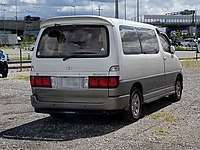 Toyota Granvia
Toyota Granvia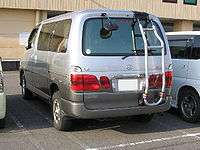 Toyota Granvia (aftermarket steps)
Toyota Granvia (aftermarket steps)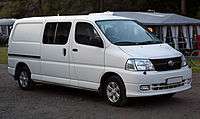 2007 HiAce Van LWB (KLH22, Europe)
2007 HiAce Van LWB (KLH22, Europe)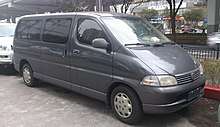 Jinbei Granse
Jinbei Granse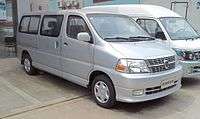 Jinbei Granse
Jinbei Granse.jpg) Jinbei Granse
Jinbei Granse Jinbei Granse
Jinbei Granse
Fifth generation (H200)
| Fifth generation (H200) | |
|---|---|
.jpg) | |
| Overview | |
| Also called |
|
| Production |
|
| Assembly |
|
| Body and chassis | |
| Body style | |
| Layout | Front-engine, rear-wheel-drive / four-wheel drive |
| Related | Toyota HiMedic |
| Powertrain | |
| Engine | |
| Transmission | |
| Dimensions | |
| Wheelbase | 2,570 mm (101.2 in) |
| Length |
|
| Width | 1,695–1,880 mm (66.7–74.0 in) |
| Height |
|
| Curb weight | 1,610–2,200 kg (3,549–4,850 lb)[34][35] |
The fifth generation HiAce became available for sale in late 2004 as a wide long-wheelbase wagon, wide super-long-wheelbase high-roof "Grand Cabin", long-wheelbase van, long-wheelbase high-roof van and a wide super-long-wheelbase high-roof van. In this generation of the HiAce, the gear lever has been moved to the dashboard to enable easier movement in the cabin. Transmission choices range from a five-speed manual and four-speed automatic.
Most models use a four-cylinder DOHC engine, in a variety of forms, a 1TR-FE 2000 cc or 2TR-FE 2,700 cc petrol engine, or a 2KD-FTV 2,500 cc or 1KD-FTV 3,000 cc D-4D turbodiesel engine. Two of these engines are available in Malaysia, the 2.5 L turbodiesel, offered in a choice of panel van or window van; and the 2.7 L petrol, that comes only in the window van option. At least some general export market HiAces are powered by the 5L-E 3,000 cc diesel engine.
In Japan, Toyota's internet-enhanced GPS and vehicle telematics service called G-Book was made available as an option on all trim packages for both private and commercial uses.
The fifth generation HiAce was launched in the Philippines on 13 June 2005, with D-4D variants; The 15-seater Commuter and the 13-seater GL Grandia, both with manual transmission. In March 2006, the new top-of-the-line 11-Seater HiAce Super Grandia was launched, being the first ever HiAce in the Philippines with a standard automatic transmission. In 2015, the 10-seater Super Grandia LXV was added in lineup, based on the GL Grandia trim, the LXV was only offered with an automatic transmission and receives 15-inch alloy wheels, updated rear seats, higher roof (campervan) and a high end audio system. The GL Grandia and Super Grandia LXV trims were sold until April 2019 and the Super Grandia trim was sold until August 2019.
The 2.5 and subsequent 3.0-litre turbodiesel KD engines have a maximum power output of 80 kW (109 PS; 107 hp) at 3400 rpm and 106 kW (144 PS; 142 hp) at 3400 rpm and maximum torque of 260 N⋅m (192 lb⋅ft) at 1600–2600 rpm and 300 N⋅m (221 lb⋅ft) at 1200–3200 rpm respectively.[36][37] The 2.0 L and 2.7 L TR petrol engines have a maximum output of 100 kW (136 PS; 134 hp) at 5600 rpm and 118 kW (160 PS; 158 hp) at 5200 rpm respectively and a maximum torque of 182 N⋅m (134 lb⋅ft) and 243 N⋅m (179 lb⋅ft); both being achieved at 4000 rpm. In November 2017, the Japanese market Hiace Van and RegiusAce came fitted with the 2.8 L 1GD-FTV engine mated to a 6-speed automatic transmission generating a power output of 111 kW (151 PS; 149 hp) at 3600 rpm and 300 N⋅m (221 lb⋅ft) of torque from 1000 to 3400 rpm. This supplanted the 1KD-FTV.[38]
On Japan's list of the most commonly stolen vehicles, as of November 2008, the HiAce resides in the first place. Because of a lack of a theft immobilizer, it is fairly easy to steal a HiAce, as opposed to much more valuable SUVs and sports cars, which have more sophisticated theft deterrent systems.[39]
Even after the newer H300 was released, as of April 2020, the H200 series continued to be sold in some countries (eg Japan, Philippines and New Zealand).[40][41] As of 2020, the H200 is the only vehicle being sold in Japan with the HiAce name.[42]
RegiusAce
The second generation of the RegiusAce was completely restyled. Transmission choices are a 5-speed manual transmission or a 4-speed automatic, with the gearshift lever integrated into the instrument panel so as to allow front seat passengers access to the rear of the vehicle from the inside. A moderate restyle was completed in November 2005. It was discontinued in 2020 due to integration of all Toyota stores across Japan.[43][44]
Mazda Bongo Brawny
For the 2019 model year, Mazda introduced a badge-engineered version of the H200 as the new Bongo Brawny.[45] Unlike its predecessors, the new Bongo is meant for commercial purposes.[45] It is offered in DX and GL trims.[46]
The Brawny is equipped with collision avoidance package as standard with forward collision warning with automatic braking, automatic high beam, and lane departure warning.[46]
Gallery
- Toyota HiAce panel long-wheelbase van (TRH200; pre-facelift)
%2C_Batu_City.jpg) Toyota HiAce Commuter (KDH200; second facelift)
Toyota HiAce Commuter (KDH200; second facelift)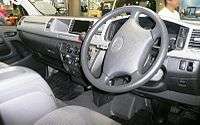 Interior with G-Book navigation
Interior with G-Book navigation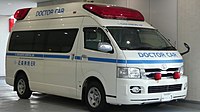 Toyota HiMedic
Toyota HiMedic
Sixth generation (H300)
| Sixth generation (H300) | |
|---|---|
.jpg) 2019 Toyota HiAce Luxury (GDH300) | |
| Overview | |
| Also called | |
| Production | 2019–present |
| Assembly |
|
| Body and chassis | |
| Body style | |
| Layout | Front-engine, rear-wheel-drive |
| Powertrain | |
| Engine | |
| Transmission | |
| Dimensions | |
| Wheelbase |
|
| Length |
|
| Width |
|
| Height |
|
| Chronology | |
| Predecessor |
|
The sixth generation HiAce made its global debut on 18 February 2019 in the Philippines. It uses a front hood/bonnet arrangement instead of a cab-over design, hence a departure from the design language of its predecessors. Its development was led by Toyota chief engineer Takuo Ishikawa.[56]
The sixth generation HiAce is available in two engine options: a turbocharged 2.8 L 1GD-FTV inline-four diesel engine or a naturally aspirated 3.5 L 7GR-FKS V6 petrol engine.[56][57][58][59]
Markets
Australia
The sixth generation HiAce was released in Australia on 28 May 2019 and is offered in five grades: LWB Van, LWB Crew Van, SLWB Van, SLWB Commuter and Commuter GL. The 3.5L V6 engine option is only available on LWB & SLWB grades.
Indonesia
The sixth generation HiAce is sold in Indonesia as the HiAce Premio (based on long/high roof body), which was introduced at the 27th Gaikindo Indonesia International Auto Show in July 2019.[60][61]
Philippines
The sixth generation HiAce is offered in 6 trim levels: Cargo, Commuter Deluxe, GL Grandia, GL Grandia Tourer, Super Grandia and Super Grandia Elite. The Super Grandia trims are sold as the Granvia/Majesty in other markets. All trim levels are powered by the 2.8-litre turbodiesel engine mated to either a 6-speed manual or automatic transmissions.
Mexico
The sixth generation HiAce was released in the Mexican market in late August 2019.[62]
Thailand
The sixth generation HiAce was launched in Thailand in 2019. There are three models of the HiAce in Thailand: HiAce (Normal Roof), Commuter (High Roof), and Majesty. The Majesty was launched on 16 August 2019, replacing the Ventury.
GranAce/Granvia/Majesty/HiAce Super Grandia/HiAce VIP
A more luxurious passenger version of the HiAce, called Granvia, was released on 21 May 2019 and is sold in Taiwan and Australia (replacing the Tarago).[63][64] The Granvia was also released in Thailand as the Majesty on 16 August 2019, replacing the Ventury,[65] followed by the HiAce Super Grandia in the Philippines on 19 August 2019.[66] It is also sold in Japan as the GranAce (Japanese: トヨタ・グランエース, Toyota Guran'ēsu), which was announced on 8 October 2019 and unveiled at the 46th Tokyo Motor Show through October to November 2019. It went on sale on 16 December 2019.[63] The Granvia was launched in the United Arab Emirates on 10 October 2019 and is powered by the 3.5-litre V6 engine.[65] It was also introduced in Russia as the HiAce VIP on 25 October 2019.[67]
Engines
| Petrol engine | |||||
|---|---|---|---|---|---|
| Engine | Power | Torque | |||
| 3.5 L 7GR-FKS DOHC 24-valve D-4S V6 with Dual VVT-i | 207 kW (281 PS; 278 hp) at 6,000 rpm[68] | 351 N⋅m (259 lb⋅ft) at 4,600 rpm[68] | |||
| Diesel engine | |||||
| Engine | Power | Torque | |||
| 2.8 L 1GD-FTV DOHC 16-valve common rail I4 with variable nozzle turbocharger (VNT) | 115 kW (156 PS; 154 hp) at 3,600 rpm[69] 120 kW (163 PS; 161 hp) at 3,600 rpm[68] 130 kW (177 PS; 174 hp) at 3,400 rpm[68] |
420 N⋅m (310 lb⋅ft) at 1,600–2,200 rpm[69] 420 N⋅m (310 lb⋅ft) at 1,600–2,200 rpm[68] 450 N⋅m (330 lb⋅ft) at 1,600–2,400 rpm[68] | |||
Safety
| Vehicle Category | MPV | |
|---|---|---|
| Number Of Airbag | 7 | |
| Score | Rating | |
| Overall | 89.51/100.00 | |
| Adult Occupant Protection | 33.35/36.00 | |
| Frontal Impact | 14.07/16.00 | |
| Side Impact | 16.00/16.00 | |
| Head Protection Technology | 3.27/4.00 | |
| Child Occupant Protection | 44.94/49.00 | |
| Frontal Impact | 15.94/16.00 | |
| Side Impact | 8.00/8.00 | |
| Safety Assist | 14.59/18.00 | |
| Effective Braking & Avoidance | 8.00/8.00 | |
| Seatbelt Reminders | 3.68/6.00 | |
| Blind Spot Technology | 0.91/2.00 | |
| Advanced SATs | 2.00/2.00 | |
Gallery
.jpg) 2019 Toyota HiAce Luxury (GDH300)
2019 Toyota HiAce Luxury (GDH300)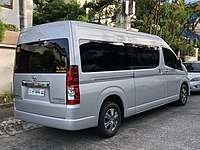 2019 Toyota HiAce GL Grandia Tourer (GDH322)
2019 Toyota HiAce GL Grandia Tourer (GDH322).jpg) 2019 Toyota HiAce Premio (GDH322)
2019 Toyota HiAce Premio (GDH322).jpg) 2019 Toyota Commuter
2019 Toyota Commuter_front.jpg) 2019 Toyota GranAce Premium (GDH303W)
2019 Toyota GranAce Premium (GDH303W)_rear.jpg) 2019 Toyota GranAce Premium (GDH303W)
2019 Toyota GranAce Premium (GDH303W).jpg) 2019 Toyota Granvia Premium
2019 Toyota Granvia Premium.jpg) 2019 Toyota Granvia Premium
2019 Toyota Granvia Premium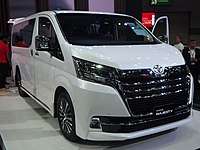 2019 Toyota Majesty Grande (GDH303)
2019 Toyota Majesty Grande (GDH303).jpg) 2019 Toyota HiAce Premio interior
2019 Toyota HiAce Premio interior_interior.jpg) 2019 Toyota GranAce Premium interior
2019 Toyota GranAce Premium interior.jpg) 1GD-FTV engine
1GD-FTV engine
References
- "Toyota Vehicle Identification Manual", Toyota Motor Corporation, Overseas Parts Department, Catalog No.97913-84, 1984, Japan
- Shioji, Hiromi (1995). "'Itaku' Automotive Production: An Aspect of the Development of Full-Line and Wide-Selection Production by Toyota in the 1960s". Kyoto University Economic Review. Kyoto University. 65 (1): 34. ISSN 0023-6055. JSTOR 43217480.
- "General Status of Plants in Japan. Honsha Plant". Toyota. Retrieved 15 December 2019.
- Padli Nurdin (22 August 2019). "Sejarah Toyota HiAce, Dari Pikap Hingga Bisnis Tour dan Travel nan Ekonomis" [The history of Toyota HiAce, from pickup to economical tour and travel business]. Cintamobil (in Indonesian). Retrieved 31 May 2020.
- 愛される車づくり。トヨタはあすにいどみます。 [Lovable car manufacture. Toyota dares to defy tomorrow.] (in Japanese), Japan: Toyota, 1972, p. 3
- Toyota Catalog (1972), p. 6
- Kawahara, Akira (2012). The Origin of Competitive Strength: Fifty Years of the Auto Industry in Japan and the U.S. Springer. ISBN 978-4-431-68419-0.
- "Vehicle Lineage: Hiace". Toyota. Retrieved 15 December 2019.
- "自動車ガイドブック [Japanese Motor Vehicles Guide Book 1978/1979]" (in Japanese). 25. Japan: Japan Automobile Manufacturers Association. 10 October 1978: 213. 0053-780025-3400. Cite journal requires
|journal=(help) - Automobile Guide Book 1978/1979, p. 294
- "Vehicle Lineage: Hiace". Toyota. Retrieved 15 December 2019.
- "Vehicle Lineage: Hiace 4th". Toyota. Retrieved 15 December 2019.
- "「ハイエース」50周年で式典 トヨタ車体" [HiAce's 50th anniversary ceremony held at Toyota Auto Body]. nikkei.com (in Japanese). Nikkei. 18 December 2017. Retrieved 15 December 2019.
- "The 4th generation HIACE H100 - Aug.1989 - Jun.2004". Carused.jp. Carpaydiem Co.,Ltd. Archived from the original on 20 April 2020.
- https://www.toyota-cd.co.jp/english/aboutus/history/
- "75 Years of Toyota - Hiace". www.toyota-global.com. Retrieved 5 July 2020.
- "Understanding the Qualities of Different HiAce Van Model Codes". Carused.jp. 3 December 2018. Retrieved 5 July 2020.
- "Micro Cars Limited". Microcars.lk. Archived from the original on 11 February 2013. Retrieved 19 July 2010.
- "金杯海狮_华晨雷诺金杯官方网站 Model Feature" [Jinbei Brilliance Renault website Model Feature] (in Chinese). China. Retrieved 22 December 2019.
- https://charter97.org/ru/news/2016/02/28/193032/
- https://wroom.ru/cars/maz/182
- http://www.gruzovikpress.ru/article/8975-obzor-semeystva-mikroavtobusov-maz-182010-nika-mazel-prizrak-jeleznogo-shkafa/
- https://www.abw.by/temp/number_pdf/759/017.pdf
- "Toyota Hiace-kundene er lei seg" [Toyota Hiace customers are upset]. Hegnar Online (in Norwegian). 22 May 2012. Archived from the original on 25 June 2012.
- "Toyota Looks to PSA Peugeot-Citroen and Fiat for its New ProAce LCV". carscoop. Retrieved 20 October 2012.
- "Jinbei Grace MPV". ChinaAutoWeb. Retrieved 20 September 2016.
- Altoveros, Jose (24 April 2019). "2019 Mazda Bongo Brawny is a rebadged Hiace delivery van". Auto News. The Philippines. Retrieved 26 April 2019.
- "Toyota upgrades 5th gen Hiace with Safety Sense for JDM - Auto News". AutoIndustriya.com. 21 April 2020.
- "Affiliates (Toyota wholly-owned subsidiaries)-Toyota Auto Body Co., Ltd". Toyota. Retrieved 14 December 2019.
- "ミニバン、トヨタ車体に移管 意思決定迅速化 委託から変更" [Transfer to Toyota Body of the minivan development from consignment for speeding up decision making]. sankeibiz.jp (in Japanese). Sankei. 29 November 2018. Retrieved 14 December 2019.
- โตโยต้าเดินเครื่องปั้นคอมมิวเตอร์ในไทย18,000คัน. Siamsport (in Thai). 10 January 2013. Archived from the original on 12 December 2013. Retrieved 22 November 2013.
- โตโยต้า ลุยผลิตรถตู้ ไฮเอซ คอมมิวเตอร์ แทนนำเข้า. Manager Online (in Thai). 12 January 2013. Retrieved 22 November 2013.
- "Toyota Caetano Portugal: Assembly of Toyota Comercials (sic)". Grupo Salvador Caetano. Retrieved 4 February 2011.
- "Specs" (PDF). toyota.jp.
- "Specs" (PDF). toyota.jp.
- "toyota.jp ハイエース". 15 July 2007. Archived from the original on 15 July 2007. Retrieved 3 December 2017.CS1 maint: BOT: original-url status unknown (link)
- "トヨタ ハイエース バン | スペック・装備 | トヨタ自動車WEBサイト". 26 March 2017. Archived from the original on 26 March 2017. Retrieved 3 December 2017.CS1 maint: BOT: original-url status unknown (link)
- CORPORATION., TOYOTA MOTOR. "トヨタ ハイエース バン | スペック・装備 | トヨタ自動車WEBサイト". toyota.jp (in Japanese). Retrieved 3 December 2017.
- Filipponio, Frank (20 November 2008). "Japan's most stolen vehicle is... not what you think". AutoBlog. US. Retrieved 6 January 2019.
- "Toyota Hiace ZL". New Zealand: Toyota. Retrieved 9 April 2020.
- "Toyota Commuter Deluxe". Philippines: Toyota Motor Philippines. Retrieved 23 July 2020.
- トヨタ ラインナップ: ビジネスカーラインナップ [Toyota Lineup: Business Car Lineup] (in Japanese), Japan: Toyota, retrieved 14 September 2019
- https://bestcarweb.jp/newcar/144775
- https://carview.yahoo.co.jp/news/detail/2bc43aa86821e6115e134488ea0f7fb370d1f4e8/
- "The Previous-Generation Toyota Hiace is Back...as a Mazda". CarGuide. Philippines. 1 May 2019. Retrieved 27 July 2019.
- "【MAZDA】マツダ、新型「ボンゴブローニイバン」を発表|ニュースリリース" [Mazda Announces New Bongo Browny Ivan] (Press release) (in Japanese). Japan: Mazda. 23 April 2019. Archived from the original on 30 June 2020. Retrieved 30 June 2020.
- "Toyota to Unveil New Model "Granace" in Japan" (Press release). Japan: Toyota. 8 October 2019. Retrieved 8 October 2019.
- "Bangkok 2019: New Toyota Commuter passenger van". 1 April 2019.
- https://www.bangkokpost.com/auto/1731491/toyota-launches-new-majesty-in-thailand
- Wong, James (21 May 2019). "2019 Toyota Granvia revealed, Tarago axed". Car Advice. Australia. Retrieved 31 May 2019.
- De Guzman, Marcus (21 May 2019). "2019 Toyota Granvia is the plusher Hiace that we want". Auto News. The Philippines. Retrieved 31 May 2019.
- https://www.zawya.com/mena/en/press-releases/story/2020_Toyota_Granvia_makes_its_grand_entry_into_the_UAEs_luxury_mover_market-ZAWYA20191009092859/
- https://www.carmag.co.za/news/new-models/new-toyota-quantum-pricing-for-south-africa-revealed/
- "Toyota to Launch New Model "Granace" in Japan" (Press release). Toyota. 25 November 2019. Retrieved 14 December 2019 – via ACN Newswire - Yahoo! News.
- "いなべ工場" [Inabe plant] (in Japanese). Toyota Auto Body. Retrieved 14 December 2019.
- "Toyota's New Hiace Series for Overseas Markets Debuts in Philippines" (Press release). Manila, Philippines: Toyota Global Newsroom. 18 February 2019. Retrieved 18 February 2019.
- "Toyota Premieres All-New HiAce in the Philippines" (Press release). Philippines: Toyota Motor Philippines. 18 February 2019. Retrieved 18 February 2019.
- De Guzman, Marcus (18 February 2019). "World Premiere in PH: 2019 Toyota Hiace starts at PhP 1.590 million". Auto Industry News. Philippines. Retrieved 18 February 2019.
- Davis, Brett (18 February 2019). "2020 Toyota HiAce revealed, gets powerful V6 option". PerformanceDrive. Australia. Retrieved 18 February 2019.
- "Tiga Jagoan Terbaru Toyota-Astra di GIIAS 2019" [Toyota-Astra's Latest Three Heroes in GIIAS 2019]. Grid (in Indonesian). Indonesia. 19 July 2019. Retrieved 21 July 2019.
- Alfons. "New Toyota HiAce Premio Resmi Meluncur, Naik RP 41Juta". Oto Driver (in Indonesian). Retrieved 19 December 2019.
- HiAce - Mexico Toyota Official Website
- "TOYOTA GRANVIA台灣全球首發 進軍豪華商旅車市場 - 自由財經". LTN: Liberty Times Net (in Chinese). 21 May 2019. Retrieved 19 December 2019.
- Wong, James. "2019 Toyota Granvia revealed, Tarago axed". CarAdvice. Retrieved 19 December 2019.
- Leu, Richard (16 August 2019). "Toyota launches new Majesty in Thailand". Bangkok Post. Retrieved 19 December 2019.
- Laurel, Drei (19 August 2019). "It's official: The 2020 Toyota Hiace Super Grandia starts at P2.42-M". Top Gear Philippines. Retrieved 19 December 2019.
- "Toyota Hiace VIP: to Russia reached a comfortable minivan". Buzz On Live. 30 October 2019. Retrieved 22 December 2019.
- "HiAce spec data" (PDF). Australia: Toyota. May 2019. Retrieved 27 July 2019.
- "Toyota HiAce Premio homepage". Indonesia: Toyota Astra. Retrieved 27 July 2019.
- "TOYOTA MAJESTY". Aseancap. 2 September 2019. Retrieved 30 June 2020.